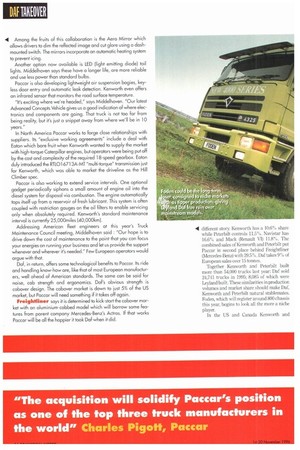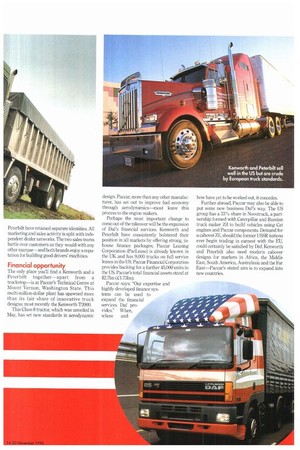• Among the fruits of this collaboration is the Aero
Page 36

Page 37

If you've noticed an error in this article please click here to report it so we can fix it.
Mirror which allows drivers to dim the reflected image and cut glare using a dashmounted switch. The mirrors incorporate an automatic heating system to prevent icing.
Another option now available is LED (light emitting diode) tail lights. Middelhoven says these have a longer life, are more reliable and use less power than standard bulbs.
Paccar is also developing lightweight air suspension bogies, keyless door entry and automatic leak detection. Kenworth even offers an infrared sensor that monitors the road surface temperature.
"It's exciting where we're headed," says Middelhoven. "Our latest Advanced Concepts Vehicle gives us a good indication of where electronics and components are going. That truck is not too far from being reality, but it's just a snippet away from where we'll be in 10 years," In North America Paccar works to forge close relationships with suppliers. Its "exclusive working agreements" include a deal with Eaton which bore fruit when Kenworth wanted to supply the market with high-torque Caterpillar engines, but operators were being put off by the cost and complexity of the required 18-speed gearbox. Eaton duly introduced the RTL016713A-MT "multi-torque" transmission just for Kenworth, which was able to market the driveline as the Hill Climber spec.
Paccar is also working to extend service intervals. One optional gadget periodically siphons a small amount of engine oil into the diesel system for disposal via combustion. The engine automatically tops itself up from a reservoir of fresh lubricant. This system is often coupled with restriction gauges on the oil filters to enable servicing only when absolutely required. Kenworth's standard maintenance interval is currently 25,000miles (40,000km).
Addressing American fleet engineers at this year's Truck Maintenance Council meeting, Middelhoven said : "Our hope is to drive down the cost of maintenance to the point that you can focus your energies on running your business and let us provide the support whenever and wherever it's needed." Few European operators would argue with that.
Dal, in return, offers some technological benefits to Paccar. Its ride and handling know-how are, like that of most European manufacturers, well ahead of American standards. The same can be said for noise, cab strength and ergonomics. Daf's obvious strength is cabover design. The cabover market is down to just 5% of the US market, but Paccar will need something if it takes off again.
Freightliner says it is determined to kick-start the cabover market with an aluminium-cabbed model which will borrow some features from parent company Mercedes-Benz's Actros. If that works Paccar will be all the happier it took Daf when it did. • different story Kenworth has a 10.6% share while Peterbilt controls 11.5%. Navistar has 16.6% and Mack (Renault VI) 11.8%. The combined sales of Kenworth and Peterbilt put Paccar in second place behind Freightliner (Mercedes-I3enz) with 29.5%. Daf takes 9% of European sales over 15 tonnes.
Together Kenworth and Peterbilt built more than 54,000 trucks last year: Daf sold 24,741 trucks in 1995; 8,085 of which were Leyland built. These similarities in production volumes and market share should make Daf, Kenworth and Peterbill natural stablemates. Foden, which will register around 800 chassis this year, begins to look all the more a niche player.
In the US and Canada Kenworth and Peterbilt have retained separate identities. All marketing and sales activity is split with independent dealer networks. The two sales teams battle over customers as they would with any other marque—and both brands enjoy a reputation for building good drivers' machines.
The only place you'll find a Kenworth and a Peterbilt together—apart from a truckstop—is at Paccar's Technical Centre at Mount Vernon, Washington State. This multi-million-dollar plant has spawned more than its fair share of innovative truck designs; most recently the Kenworth 12000.
This Class-8 tractor, which was unveiled in May, has set new standards in aerodynamic design. Paccar, more than any other manufacturer, has set out to improve fuel economy through aerodynamics—most leave this process to the engine makers.
Perhaps the most important change to come out of the takeover will be the expansion of Daf's financial services. Kenworth and Peterbilt have consistently bolstered their position in all markets by offering strong, inhouse finance packages; Paccar Leasing Corporation (PacLease) is already known in the UK and has 9,000 trucks on full service leases in the US. Paccar Financial Corporation provides backing for a further 45,000 units in the US. Paccar's total financial assets stand at $2.7bn (£1.73bn).
Paccar says: "Our expertise and highly developed finance sys tems call be used to expand the financial services Daf provides." When, where and how have yet to be worked out., it concedes.
Further abroad, Paccar may also be able to put some new business Daf's way. The US group has a 33% share in Novotruck, a partnership formed with Caterpillar and Russian truck maker Zil to build vehicles using Cat engines and Paccar components. Demand for a cabover Zil, should the former USSR nations ever begin trading in earnest with the EU, could certainly be satisfied by Daf. Kenworth and Peterbilt also need modern cabover designs for markets in Africa, the Middle East, South America, Australasia and the Far East—Paccar's stated aim is to expand into new countries.
















































































































